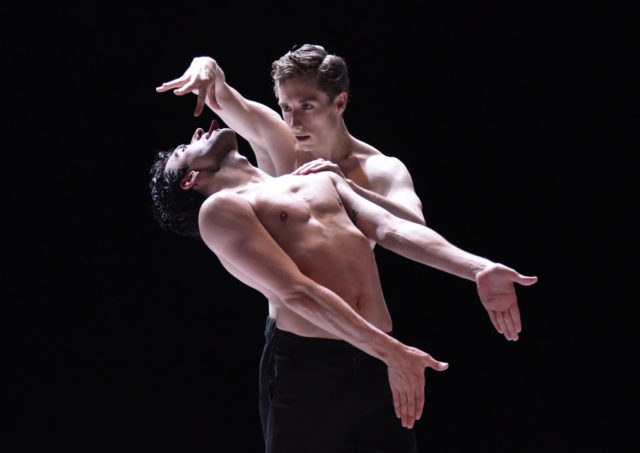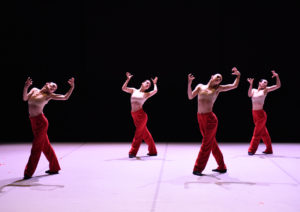
For the English version, please, scroll down.
Giovedì 25, venerdì 26 e sabato 27 gennaio, presso l’Haus der Berliner Festspiele andrà in scena la Gauthier Dance Company Theaterhaus Stuttgart con Nijinski di Marco Goecke.
Dopo il loro intenso ma breve debutto a Berlino alla Serata culturale del Presidente dell’Assemblea federale tedesca nel giugno 2013, Gauthier Dance avrà finalmente una debita anteprima nella capitale tedesca! Sebbene la compagnia rappresenti l’avanguardia della danza internazionale e si sia esibita in città come New York, Mosca, Tel Aviv, Toronto, Madrid o Seoul – Berlino era rimasta una macchia bianca sulla mappa di Gauthier Dance touring. Finora…
Alla sua première nell’estate 2016, il balletto integrale di Marco Goecke (Resident Choreographer dello Stuttgart Ballet e Associate Coreographer del Nederlands Dans Theater all’Aja) è stato accolto con entusiasmo dalla critica e dal pubblico e da allora ha ricevuto numerosi premi e riconoscimenti dai media specializzati internazionali.
Il pezzo si concentra sulla vita del leggendario ballerino e coreografo Vaslav Nijinski. Tocca fasi significative della sua vita dentro e fuori dal palcoscenico, esplorando lo stretto rapporto tra arte e follia.
Nijinski è stato uno degli artisti più straordinari del secolo scorso e ha fatto la storia della danza con parti come il clown di Petrushka di Igor Stravinskij, il Fantasma della Rosa in Le Specter de la rose e lo schiavo d’oro di Sheherazade. Ma sono state le sue coreografie pionieristiche che hanno stupito il mondo e stabilito nuovi standard nella danza. La prima di Parigi del Le Sacre du Printemps di Nijnski nel 1913 ha creato quello che è ancora considerato uno dei più grandi scandali nella storia del teatro. L’erotismo non mascherato del suo balletto L’Après-midi d’un faune, ispirato allo squisito pezzo di Claude Debussy, ha causato ulteriore indignazione nei salotti di Parigi.
La carriera di Nijinski è strettamente legata al suo percorso verso la follia. Stava combattendo la schizofrenia e doveva gradualmente ritirarsi dalla vita pubblica. Nijinksi ha vissuto entrambe le guerre mondiali e, quando è stato ricoverato in un ospedale psichiatrico, è sfuggito per un pelo alla morte dal programma di eutanasia del NS, insieme alla moglie Romola.
Il pezzo di Goecke va oltre gli aspetti biografici, affrontando questioni psicologiche fondamentali.
Nijinski riflette sulla magia e il valore dell’arte – e il prezzo elevato che esige dalle menti creative.
Haus der Berliner Festspiele
Thursday, January 25, 2018 at 8:00 p.m. / Friday, January, 26, 2018 at 8:00 p.m. (audience discussion after the performance) / Saturday, January 27, 2018 at 8:00 p.m.
Gauthier Dance//Dance Company Theaterhaus Stuttgart
NIJINSKI
Following their intense but short Berlin debut at the Cultural Evening of the President of the Germany Federal Assembly in June 2013, Gauthier Dance will finally have a proper premiere in the German capital! For the company may well have danced its way to the international forefront and appeared in cultural cities such as New York, Moscow, Tel Aviv, Toronto, Madrid or Seoul – Berlin has remained a white spot on the Gauthier Dance touring map. Till now…
At its première in summer 2016, the full-length ballet by Marco Goecke (Resident Choreographer of the Stuttgart Ballet and Associate Choreographer of Nederlands Dans Theater in The Hague) was greeted with enthusiasm by both critics and audiences and has since received numerous awards and honours from the international specialist media. The piece focuses on the life of the legendary dancer and choreographer Vaslav Nijinski. It touches on significant stages of his life on and off-stage, exploring the close relationship between art and madness.
Nijinski was one of the most extraordinary artists of the last century and made dance history with parts like the clown in Igor Stravinsky’s Petrushka, the Ghost of the Rose in Le Spectre de la rose and the Golden Slave in Sheherazade. But it is was his pioneering choreographies that astounded the world and set new standards in dance. The Paris première of Nijnski’s Le Sacre du printemps in 1913 created what is still considered one of the greatest scandals in the history of theatre. The undisguised eroticism of his ballet L’Après-midi d’un faune, inspired by Claude Debussy’s exquisite piece, caused further outrage in the Paris salons.
Nijinski’s career is closely linked with his path towards madness. He was fighting schizophrenia and had to gradually withdraw from public life. Nijinksi lived through both world wars and, when a patient in a psychiatric hospital, he narrowly escaped death by the NS euthanasia programme, along with his wife Romola.
Typically for Goecke, his piece moves beyond biographical aspects, addressing fundamental psychological issues. NIJINSKI reflects on the magic and the value of art – and the high price it exacts from creative minds.
iscriviti alla newsletter campadidanza.it















































